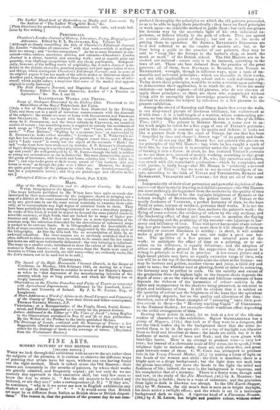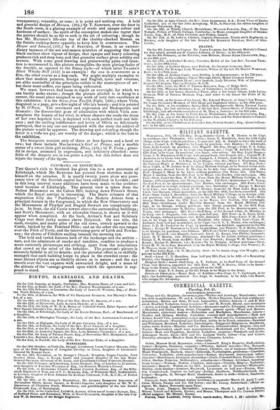FINE ARTS.
MODERN PICTURES AT THE BRITISH INSTITUTION.
[SECOND NOTICE.]
WHEN we look through this exhibition with an eye to the art rather than the subjects of the pictures, it is curious to observe the different ways of painting that artists have hit upon, without any one having found out the right method. Much is talked about the Old Masters ; their names are constantly in the mouths of painters, by whom their works are greatly admired, and frequently copied ; yet not only do we see scarcely any approach to their executive skill, but very few seem to know the way to attain it. " Are the old masters to be studied and imitated, or are they not ?" asks a correspondent (J. D.) " If they are," he continues, " why is it we never see now in English exhibitions any shadow or sign of them ?" * * " It would seem that British art must be as different from Italian as British skies or British disposi- tions." The reason is, that the painters of the present day do not coin- prebend thoroughly the principles on which the old painters proceeded, so as to be able to apply them practically : they have no fixed principles to work upon—no scientific method to guide them ; but each one gropes his devious way by the uncertain light of his own individual ex- perience, or follows blindly in the path of others. They are agreed on certain abstract points of theory ; but not as to the mode of putting them in operation. Sir JOSHUA REYNOLDS'S Discourses are re..d and referred to as the oracles of modern art ; but, so far from being a guide to the practice of our painters, they may be said to " hang like the forceps in the barber's shop, as much the mock as mark " of the British school. The Old Masters are to be studied, not imitated : nature only is to be imitated, according to the laws of art. These are best deduced from the practice of the great painters : all of them, from RAPHAEL IO RUBENS, from TITIAN to REMBRANDT, wrought, though in different ways, upon a basis of im- mutable and universal :principles ; which are traceable in their works, and are alike applicable to every school and to each individual style. To lay down these principles, would be to write a treatise upon painting; to demonstrate their application, is to teach the art. There are many imitators—or rather copiers—of old pictures, who do not observe or apply these principles ; as there are those who comprehend without being able to exemplify their knowledge practically. We will en- deavour to elucidate the subject by reference to a few pictures hi the present exhibition. Among the crowd of flaunting and flimsy daubs that cover the walls, is one deep-toned picture of luminous brilliancy, but embrowned as if with time : it is a half-length of a warrior, whose commanding pre- sence, no less than his habiliments, proclaim him to be One of the Olden Time, (337.) The painter is MORRIS MOORE, a name new to us : his work might be taken for a fine copy of one of TITIAN'S portraits ; and in this remark is summed up its merits and defects : it looks not like a picture fresh from the easel of TITIAN, but one that has been " despoiled by time and cleaner's fiercer rage" of its purity and fresh- ness. We do not say that Mr. MOORE has not painted this picture on the principles of the Old Masters ; but, while he has caught a spark of their fire, he has allowed it to smoulder under the dust of age instead of fanning it into a flame : in short, he has imitated TITIAN'S portraits as we see them now, instead of merely working according to that great master's method. We agree with J. D., who, like ourselves and others, was struck with this remarkable production—which he complains, and with justice, is badly hung—that Mr. Mooan is " evidently a devoted worshiper of Titian " : but we want to see devoted worshipers of na- ture, according to the faith of TITIAN and TINTORETTO, RUBENS and REMBRANDT, VELASQUEZ and VANDYKE ; for they are all of the same creed.
Independently of their clear perception and powerful depiction of cha- racter—of their masterly drawing and skilful execution—the Old Masters are most strikingly distinguished from the moderns by the quality of tone in colouring : whether it be the daylight brightness of RUBENS or the solemn twilight of REMBRANDT, the golden lustre of TITIAN or the pearly freshness of VANDYKE, a perfect harmony of tints, be the hues florid or sober, intense or subdued, pervades their works. It is not the effect of time ; which rather dims than mellows the painter's work : the flying of some colours, the subduing of others by the oily medium, and the blackening effect of dust and smoke—not to mention the flaying of the cleaning and the poulticiug of the restorer—are injurious to har- mony and brilliancy of tone. Time will never harmonize crude colour- ing, nor give lustre to opacity, any more than it will change flatness to rotundity or convert flimsiness to solidity : in short, it will neither make a good picture of a bad one, nor make a good one bet- ter. The qualities of a fine picture are integral parts of the work : to anticipate the effect of time on a painting, or to cal- culate on its influence, is equally fallacious ; and the adoption of either course affords ground for the supposition that the painter is wrong in principle as well as in practice. A low-toned picture and a high-toned picture may have an equally extensive range of tints, only one will be at the top of the chromatic scale the other at the bottom: one may be lustrous and golden, another vinous and juicy, a third dry and quiet in tone ; but whether cool or glowing, florid or sober in colouring, the harmony may be perfect in each. On the subtilty and extent of the gradations from the highest light to the deepest shade depends the depth of tone ; as on the variety of tints and felicitous contrasts of hues depends the richness of the harmonies of colour—solidity in the lights and transparency in the shadows being preserved, as essential to depth and brilliancy of tone. It will be evident that it is neither on the quantity of colour nor the brightness of the hues that the splendour of a painting depends, but on the quality and allocation of the tints : therefore, some of the finest examples of " colouring " have little posi- tive colour in them— the " Mercury teaching Cupid" of Costasocio, in the National Gallery, for example—their wondrous effect depending on the artful arrangement of tints.
Bearing these points in mind, let us look at a few of the life-size studies of character in this exhibition. Signor GAMBARDELLA has a group of Beggars, (312,) that look as if they were in a dungeon, did not the black leaden sky in the background show that the artist in- tended them to be in the open air: not a ray of daylight can illumine faces so livid and bloodless as these ; the heads are solid, but it is the hardness of metal, not of bone and flesh ; and the eyes gleam with bead-like lustre. Here is an attempt to produce tone—a very low tone ; but instead of a chromatic scale of fifty notes, (so to speak,) from brightest light to darkest shade, there are only about five, and great gaps between some of these. C. W. COPE has attempted to produce tone in his Young Flemish Mother, (27,) by making a focus of light on the heads of the woman and child : the trick is manifest; there is a bright spot on a dingy background ; but the light does not melt into the gloom insensibly, nor have the heads in the light the relief and fleshiness of life ; indeed, the man in the background is vaporous, and his complexion that of a mummy. There is a fleshy tone, though cold and raw, in the study of the Jew Merchant, (46,) by A. MORTON: but the handling is feeble ; there is a want of substance, and the gradation from light to dark is likewise too abrupt. In the Old Earth-Stopper, (62,) by W. &BISON, the old man's face is seen as in bright daylight, his dress ander a twilight effect; and the whole is set in a landscape background dark as night. A vigorous head of a Florentine Senator, (392,) by J. M. Duos, has bright and positive colour, without either transparency, rotundity, or tone ; it is paint and nothing else. A bold and graceful design of Miriam, (295.) by T. Saisusort, over the door in the South room, is a glaring example of crude and opaque colour and hardness of surface : the spirit of the conception makes one regret that the painter should be so far to seek in the art of colouring ; though he has Mr. HAYDON'S life-size toy of the chubby-checked Roman on the frantic rocking-horse opposite, to keep him in countenance. The Hagar and Ishmad, (197,) by J. STEVENS, of Rome, is an extraor- dinary instance of the not uncommon mistakes of supposing that hard black outlines show vigour of design, that opaque and heavy colouring produces rich and deep tone, and that granular surface gives solidity and texture. With some good drawing and praiseworthy pains and inten- tion to recommend it, this picture exemplifies the most glaring faults of the forcible, as opposed to the flimsy style—of which latter FRASER'S Illicit Whisky Still (412.) is an example the one is evanescent as a film, the other coarse as a hop-sack. We might multiply examples to show that modern painters, foreign and English, tyros and veterans, are alike unmindful of the principles visible in the masterpieces of art : but these must suffice, our space being exhausted. We must, however, find room to repair an oversight, for which We can hardly make excuse; though the picture alluded to is hung in a corner, the usual place assigned to any work of very rare excellence at this exhibition : it is the Scene from Twelfth Night, (239,) where Viola, disguised as a page, gets a first sight of Olivia's beauty ; and it is painted by H. O'NEIL. The sentiment and expression are Shaksperian and dramatic : the disconsolate gaze of admiration with which Viola con- templates the beauty of her rival, in whose charms she reads the doom of her own hopeless love, is depicted with such perfect truth and deli- cacy ; and the smiling indifference and levity of Olivia so felicitously portrayed, that to any one not acquainted with the story the subject of the picture would be apparent. The drawing and colouring, though the latter is a trifle too gay, are worthy of the design ; which is the best in the exhibition.
The Sculpture consists only of three or four figures and a head or two; but these include MACDOWELL'S Girl at Prayer, and a marble statue of a sweet little girl reclining, Eliza, (432,) by P. PARK ; grace- ful in design, animated in expression, and delicately chiselled : some folds of the drapery are in too petite a style, but this defect does not injure the beauty cf the figure.



























 Previous page
Previous page